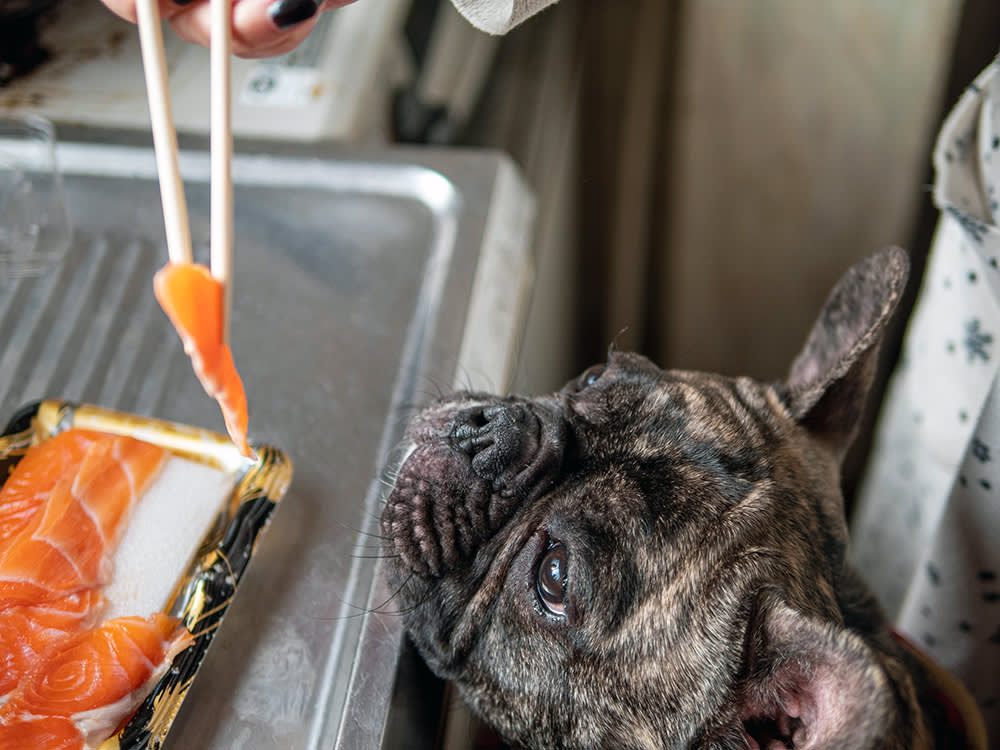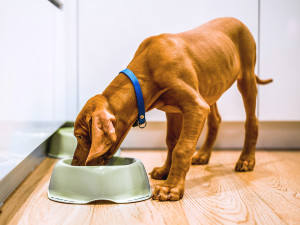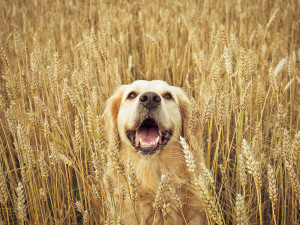10 Healthy “People” Foods for Dogs
You might be surprised that these common health foods are totally safe for pups.

Share Article
If you’re going to feed your dogs “people” food, shouldn’t you feed them something that’s actually good for them? Fortunately, there are plenty of healthy, easily obtainable options straight from the store that can be added to liven up your pup’s meals.
Of course, there are a few things to keep in mind before getting started. First, none of these “people” foods by themselves constitutes a “complete and balanced” meal, and if your dog has health or weight issues, check with your vet before introducing them. Next, although it might seem like your dog is willing to eat almost anything they find (Socks? Seriously?), dogs can be surprisingly picky about new things in their food bowls. Start with a small portion to see if it’s something they are into … or not. And finally, always introduce new foods to your dog gradually. Here are ten human foods that are safe to give to your dog.
1. Parsley
Parsley freshens dog breath in addition to providing phytochemicals. Beyond fresh breath, parsley also has Vitamin C, Vitamin K, carotenoids, B vitamins, iron, and limonene (an oil that kills bad mouth bacteria). Italian flat-leaf parsley has a stronger odor and flavor than the curly leaf variety but a similar nutritional profile.
How to add parsley to your dog’s food: When giving your dog parsley, stick with the fresh stuff. Just chop it and sprinkle a small amount with your dog’s food (too much parsley can act as a diuretic).

2. Flaxseeds
Flaxseeds are a great choice to add to your dog’s diet. These small seeds — known for their alpha-linolenic acid (ALA) content and their benefits to a dog’s coat, skin, bone, and brain function — pack a big nutritional punch. Flaxseeds are also high in fiber and lignans (a fiber type), which may be beneficial for insulin action. They are a great source of manganese, pyridoxine, magnesium, phosphorus, and copper. Flaxseeds also contain the B vitamin folate, which is important for cell regulation.
How to add flaxseeds to your dog’s food: Grind fresh flaxseeds, which are nutty and crunchy, then add the ground seeds to your dog’s food and increase the nutrient density of any meal. Alternatively, flaxseed oil is also available in most health food stores and contains a more concentrated amount of ALA; add a teaspoon of oil to your pup’s meal. (Note: Store in refrigerator to maintain freshness.)
3. Yogurt
The active cultures in yogurt known as probiotics (necessary, friendly bacteria) help keep the bad bacteria away. Yogurt, which may improve your dog’s gut function, contains a number of nutrients, including protein, calcium, phosphorus, Vitamin B12, potassium, zinc, and iodine. It is also a fair source of other B vitamins, such as riboflavin and pantothenic acid (required for enzyme action and energy production, as well as other cellular functions).
How to add yogurt to your dog’s food: This one is super easy. Just add a dollop of non-fat plain yogurt to your dog’s bowl or pick up some probiotics (acidophilus cultures) from your local health food store. Yogurt is a great way to disguise some yucky medicines.
4. Salmon
Salmon is bursting with omega-3 fatty acids, essential fatty acids (EFAs), which help dogs thrive. Omega-3s do wonders for a dog’s skin, coat and brain, as well as limit inflammatory processes that cause them arthritic pain and other chronic canine conditions. (If your dog has any of these conditions, ask your vet if fish oil in capsule form might help.) Salmon is also an excellent protein source, with many essential vitamins and minerals.*
How to add salmon to your dog’s food: When you’re cooking salmon steaks for yourself, toss a few extra on the barbeque for your dog. Refrigerate or dehydrate the grilled chunks of salmon and serve them to your dog cold.
5. Nori
Dried edible seaweed (red algae species), a Japanese staple, is a nutritious food for dogs. Often associated with sushi, nori is available in many stores and certainly in those with Asian food sections. Nori has protein, galactans (a soluble fiber), Vitamins C, E and all the Vitamin Bs, and minerals such as zinc and copper. It also has some lesser-known sterols and chlorophyll, which have been investigated for their effects on regulating metabolism. Nori may have beneficial effects on a dog’s fat metabolism, immune function, and anti-tumor response.
How to add nori to your dog’s food: Nori does not have a strong odor or flavor, and the paper-thin sheets can be torn and soaked in broth, then added to food, or just added to your dog’s food dry. Puppy sushi, anyone?
6. Cranberries
Did you know that dogs can eat cranberries? This fruit is an excellent source of Vitamin C, fiber, and manganese. Cranberries also contain Vitamin K and phytochemicals thought to inhibit the ability of bad bacteria to stick to and infect a dog’s urinary tract. In addition, there may be benefits for blood vessel health and antioxidant protection.
How to add cranberries to your dog’s food: While dogs can eat cranberries, they might not want to. Cranberries are very sour, and not everyone enjoys them. It really depends on your dog’s particular preference. To offset their tartness, you could try to combine them with sweeter fruit, such as a banana or ripe papaya, for a healthful treat. Alternatively, cook them or serve them dried. If you’re buying the premade stuff, ensure there are no harmful additives like raisins, sugar, salt, or xylitol.
7. Sardines
Like mackerel, sardines are a terrific protein source for dogs. They contain appreciable amounts of the amino acid tryptophan as well as Omega-3 fatty acids and Vitamin B-12 (a hard-to-come-by B vitamin that is essential for cell function). They are a good source of selenium, calcium, and phosphorus. Packed with Vitamin D, Vitamin B-3 (niacin) and Vitamin A in its preformed state, sardines are a great addition to any dog’s diet.
How to add sardines to your dog’s food: Choose a low-sodium, water-packed sardine and mash well. After mashing, check for and remove obvious bones, which can lodge in the esophagus or splinter and cause dangerous tears in the gut.
8. Wheat Grass
Sometimes called pet grass or cat grass because of its popularity with cats, this plant is the young grass of the wheat plant. Though it doesn’t have the same composition as wheat, it has chlorophyll, fiber, Vitamin E, phosphorus, magnesium, iron, potassium, as well as some protein and carotenoids. Wheatgrass can aid in removing toxins from your dog’s body, help ward off infection, and is also purported to decrease constipation and help with upset stomachs.
How to add wheatgrass to your dog’s food: Buy or grow a pot of wheatgrass and make it available to your dog. Many dogs eat grass, and wheatgrass is an improvement over the potentially herbicide-laden, contaminated grass growing along the curb.
9. Rosemary
An aromatic relative of mint, rosemary is safe for dogsopens in new tab and has many health benefits. Rosemary provides some fiber, iron, and calcium in addition to several phytochemicals thought to improve immune function and act as anti-inflammatory agents and antioxidants. Dogs have been known to love romping around in rosemary bushes, so plant it in your yard, and you’ll find your home smelling of the fresh fragrance. Added bonus: Rosemary acts as a natural bug repellant.
How to add rosemary to your dog’s food: Wash a sprig of fresh rosemary and add the minced needles (leaves) to the food.
10. Nutritional Yeast
Not to be confused with active yeast, this inactive yeast is an excellent addition to a dog’s diet. Grown on mineral-enriched molasses and used as a food supplement, nutritional yeast is high in protein, B vitamins, chromium, and several other minerals. Protein is needed for a dog’s muscle and cell growth. B vitamins are essential for energy metabolism and enzyme function. Chromium is important for insulin release and action, allowing carbohydrates and other fuels to be taken up by the cells and used or stored.
How to add nutritional yeast to your dog’s food: Don’t overdo it, as too much chromium can cause unpleasant side effects. Use one teaspoon for a small dog, two tsp. for a medium dog and one tbsp. for a large dog. Mix it with your dog’s food and introduce it slowly.
*The Environmental Protection Agencyopens in new tab (EPA) monitors the levels of mercury and industrial chemicals that end up in fish, both fresh- and saltwater; updates regarding contamination are readily available.
Roschelle Heuberger, PhD
Roschelle Heuberger, PhD, is a Registered Dietitian, an Associate Professor of Nutrition and director of the Clinical Nutrition graduate program at Central Michigan University.
Related articles
![brown puppy eating food out of green bowl]()
A Digestible Guide to Healthy Dog Food for Your New Pup
How to pick the right grub for your dog when there are So. Many. Choices.
![Dog biting into a bunch of carrots]()
How to Get Your New Dog the Vitamins and Minerals They Need
Your pup needs their greens, too.
![Dog Sitting In A Field]()
8 Super Seeds to Add to Your Dog’s Diet
From chia to pumpkin, seeds pack a major nutritional punch.


